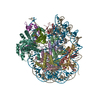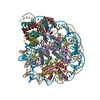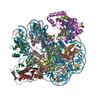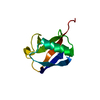[English] 日本語
 Yorodumi
Yorodumi- EMDB-46731: Composite map of ncPRC1RYBP bound to singly modified H2AK119Ub nu... -
+ Open data
Open data
- Basic information
Basic information
| Entry |  | ||||||||||||
|---|---|---|---|---|---|---|---|---|---|---|---|---|---|
| Title | Composite map of ncPRC1RYBP bound to singly modified H2AK119Ub nucleosome | ||||||||||||
 Map data Map data | Composite map of ncPRC1RYBP bound to singly modified H2AK119Ub nucleosome | ||||||||||||
 Sample Sample |
| ||||||||||||
 Keywords Keywords | DNA complex protein / hydrolase / structural protein / NUCLEAR PROTEIN-DNA complex / GENE REGULATION | ||||||||||||
| Biological species |  Homo sapiens (human) / Homo sapiens (human) / | ||||||||||||
| Method | single particle reconstruction / cryo EM / Resolution: 3.0 Å | ||||||||||||
 Authors Authors | Godinez-Lopez V / Valencia-Sanchez MI / Armache JP / Armache K-J | ||||||||||||
| Funding support |  United States, 3 items United States, 3 items
| ||||||||||||
 Citation Citation |  Journal: Nature / Year: 2024 Journal: Nature / Year: 2024Title: Read-write mechanisms of H2A ubiquitination by Polycomb repressive complex 1. Authors: Victoria Godínez López / Marco Igor Valencia-Sánchez / Stephen Abini-Agbomson / Jonathan F Thomas / Rachel Lee / Pablo De Ioannes / Brian A Sosa / Jean-Paul Armache / Karim-Jean Armache /  Abstract: Epigenetic inheritance of silent chromatin domains is fundamental to cellular memory during embryogenesis, but it must overcome the dilution of repressive histone modifications during DNA replication. ...Epigenetic inheritance of silent chromatin domains is fundamental to cellular memory during embryogenesis, but it must overcome the dilution of repressive histone modifications during DNA replication. One such modification, histone H2A lysine 119 monoubiquitination (H2AK119Ub), needs to be re-established by the Polycomb repressive complex 1 (PRC1) E3 ligase to restore the silent Polycomb domain. However, the exact mechanism behind this restoration remains unknown. Here, combining cryo-electron microscopy (cryo-EM) and functional approaches, we characterize the read-write mechanism of the non-canonical PRC1-containing RYBP (ncPRC1). This mechanism, which functions as a positive-feedback loop in epigenetic regulation, emphasizes the pivotal role of ncPRC1 in restoring H2AK119Ub. We observe an asymmetrical binding of ncPRC1 to H2AK119Ub nucleosomes, guided in part by the N-terminal zinc-finger domain of RYBP binding to residual H2AK119Ub on nascent chromatin. This recognition positions the RING domains of RING1B and BMI1 on the unmodified nucleosome side, enabling recruitment of the E2 enzyme to ubiquitinate H2AK119 within the same nucleosome (intra-nucleosome read-write) or across nucleosomes (inter-nucleosome read-write). Collectively, our findings provide key structural and mechanistic insights into the dynamic interplay of epigenetic regulation, highlighting the significance of ncPRC1 in H2AK119Ub restoration to sustain repressive chromatin domains. | ||||||||||||
| History |
|
- Structure visualization
Structure visualization
| Supplemental images |
|---|
- Downloads & links
Downloads & links
-EMDB archive
| Map data |  emd_46731.map.gz emd_46731.map.gz | 29.3 MB |  EMDB map data format EMDB map data format | |
|---|---|---|---|---|
| Header (meta data) |  emd-46731-v30.xml emd-46731-v30.xml emd-46731.xml emd-46731.xml | 28.6 KB 28.6 KB | Display Display |  EMDB header EMDB header |
| Images |  emd_46731.png emd_46731.png | 122.8 KB | ||
| Filedesc metadata |  emd-46731.cif.gz emd-46731.cif.gz | 5.3 KB | ||
| Others |  emd_46731_additional_1.map.gz emd_46731_additional_1.map.gz emd_46731_additional_2.map.gz emd_46731_additional_2.map.gz emd_46731_additional_3.map.gz emd_46731_additional_3.map.gz | 27.9 MB 56.8 MB 59.7 MB | ||
| Archive directory |  http://ftp.pdbj.org/pub/emdb/structures/EMD-46731 http://ftp.pdbj.org/pub/emdb/structures/EMD-46731 ftp://ftp.pdbj.org/pub/emdb/structures/EMD-46731 ftp://ftp.pdbj.org/pub/emdb/structures/EMD-46731 | HTTPS FTP |
-Validation report
| Summary document |  emd_46731_validation.pdf.gz emd_46731_validation.pdf.gz | 463.5 KB | Display |  EMDB validaton report EMDB validaton report |
|---|---|---|---|---|
| Full document |  emd_46731_full_validation.pdf.gz emd_46731_full_validation.pdf.gz | 463.1 KB | Display | |
| Data in XML |  emd_46731_validation.xml.gz emd_46731_validation.xml.gz | 6.4 KB | Display | |
| Data in CIF |  emd_46731_validation.cif.gz emd_46731_validation.cif.gz | 7.4 KB | Display | |
| Arichive directory |  https://ftp.pdbj.org/pub/emdb/validation_reports/EMD-46731 https://ftp.pdbj.org/pub/emdb/validation_reports/EMD-46731 ftp://ftp.pdbj.org/pub/emdb/validation_reports/EMD-46731 ftp://ftp.pdbj.org/pub/emdb/validation_reports/EMD-46731 | HTTPS FTP |
-Related structure data
- Links
Links
| EMDB pages |  EMDB (EBI/PDBe) / EMDB (EBI/PDBe) /  EMDataResource EMDataResource |
|---|---|
| Related items in Molecule of the Month |
- Map
Map
| File |  Download / File: emd_46731.map.gz / Format: CCP4 / Size: 64 MB / Type: IMAGE STORED AS FLOATING POINT NUMBER (4 BYTES) Download / File: emd_46731.map.gz / Format: CCP4 / Size: 64 MB / Type: IMAGE STORED AS FLOATING POINT NUMBER (4 BYTES) | ||||||||||||||||||||||||||||||||||||
|---|---|---|---|---|---|---|---|---|---|---|---|---|---|---|---|---|---|---|---|---|---|---|---|---|---|---|---|---|---|---|---|---|---|---|---|---|---|
| Annotation | Composite map of ncPRC1RYBP bound to singly modified H2AK119Ub nucleosome | ||||||||||||||||||||||||||||||||||||
| Projections & slices | Image control
Images are generated by Spider. | ||||||||||||||||||||||||||||||||||||
| Voxel size | X=Y=Z: 1.0826 Å | ||||||||||||||||||||||||||||||||||||
| Density |
| ||||||||||||||||||||||||||||||||||||
| Symmetry | Space group: 1 | ||||||||||||||||||||||||||||||||||||
| Details | EMDB XML:
|
-Supplemental data
-Additional map: Overall map ncPRC1RYBP bound to singly modified H2AK119Ub...
| File | emd_46731_additional_1.map | ||||||||||||
|---|---|---|---|---|---|---|---|---|---|---|---|---|---|
| Annotation | Overall map ncPRC1RYBP bound to singly modified H2AK119Ub nucleosome, map 1, resampled on Map 3 | ||||||||||||
| Projections & Slices |
| ||||||||||||
| Density Histograms |
-Additional map: DeepEMhancer map focused on NZF RYBP of ncPRC1RYBP...
| File | emd_46731_additional_2.map | ||||||||||||
|---|---|---|---|---|---|---|---|---|---|---|---|---|---|
| Annotation | DeepEMhancer map focused on NZF RYBP of ncPRC1RYBP bound to singly modified H2AK119Ub nucleosome, map 2, resampled on map3 | ||||||||||||
| Projections & Slices |
| ||||||||||||
| Density Histograms |
-Additional map: Sharpened map focused on RING1B/BMI1 of ncPRC1RYBP bound...
| File | emd_46731_additional_3.map | ||||||||||||
|---|---|---|---|---|---|---|---|---|---|---|---|---|---|
| Annotation | Sharpened map focused on RING1B/BMI1 of ncPRC1RYBP bound to singly modified H2AK119Ub nucleosome,map 3, B-factor -63.7 | ||||||||||||
| Projections & Slices |
| ||||||||||||
| Density Histograms |
- Sample components
Sample components
+Entire : ncPRC1RYBP bound to singly modified H2AK119Ub nucleosome
+Supramolecule #1: ncPRC1RYBP bound to singly modified H2AK119Ub nucleosome
+Supramolecule #2: Histones
+Supramolecule #3: DNA
+Supramolecule #4: ncPRC1-RYBP
+Supramolecule #5: Ubiquitin
+Supramolecule #6: Histone H3.2
+Supramolecule #7: Histone H4
+Supramolecule #8: Histone H2A
+Supramolecule #9: Histone H2B 1.1
+Supramolecule #10: DNA (153-MER)
+Supramolecule #11: DNA (156-MER)
+Supramolecule #12: Polycomb complex protein BMI-1
+Supramolecule #13: E3 ubiquitin-protein ligase RING2, Ubiquitin-conjugating enzyme E2 D3
+Supramolecule #14: RING1 and YY1-binding protein
-Experimental details
-Structure determination
| Method | cryo EM |
|---|---|
 Processing Processing | single particle reconstruction |
| Aggregation state | particle |
- Sample preparation
Sample preparation
| Concentration | 0.1 mg/mL |
|---|---|
| Buffer | pH: 7.5 |
| Vitrification | Cryogen name: ETHANE / Chamber humidity: 100 % / Chamber temperature: 298 K / Instrument: FEI VITROBOT MARK IV |
- Electron microscopy
Electron microscopy
| Microscope | TFS KRIOS |
|---|---|
| Image recording | Film or detector model: GATAN K3 (6k x 4k) / Number real images: 10157 / Average electron dose: 50.7 e/Å2 |
| Electron beam | Acceleration voltage: 300 kV / Electron source:  FIELD EMISSION GUN FIELD EMISSION GUN |
| Electron optics | Illumination mode: OTHER / Imaging mode: BRIGHT FIELD / Nominal defocus max: 2.5 µm / Nominal defocus min: 0.8 µm |
| Experimental equipment |  Model: Titan Krios / Image courtesy: FEI Company |
+ Image processing
Image processing
-Atomic model buiding 1
| Initial model |
| |||||||||||||||||||||||||||
|---|---|---|---|---|---|---|---|---|---|---|---|---|---|---|---|---|---|---|---|---|---|---|---|---|---|---|---|---|
| Refinement | Space: REAL / Protocol: OTHER |
 Movie
Movie Controller
Controller

















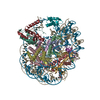
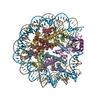
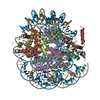


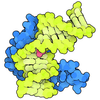

 X (Sec.)
X (Sec.) Y (Row.)
Y (Row.) Z (Col.)
Z (Col.)













































